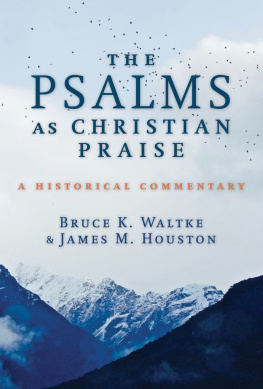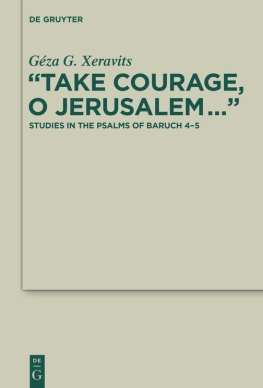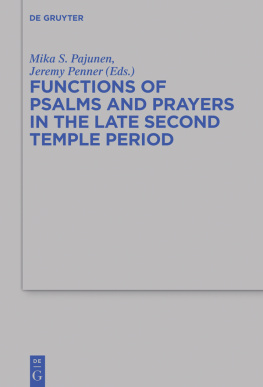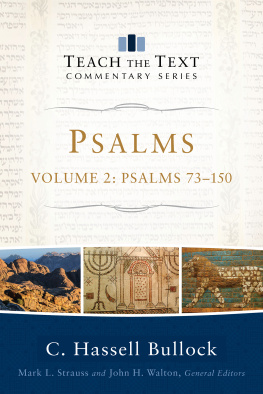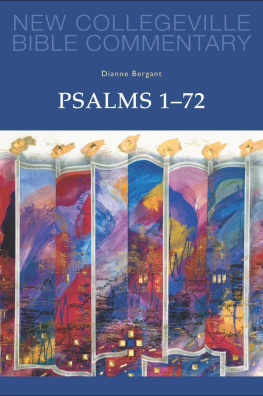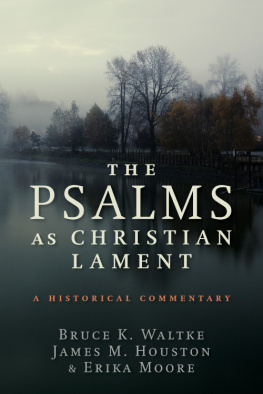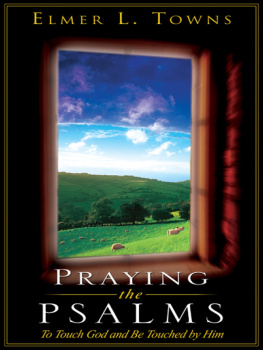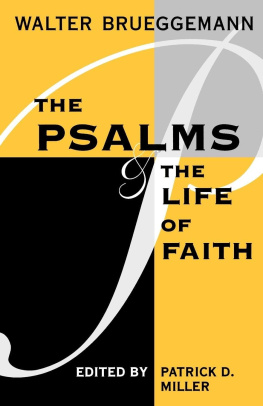Contents
Guide

Psalms In/On Jerusalem
Perspectives on Jewish Texts and Contexts

Edited by
Vivian Liska
Editorial Board
Robert Alter, Steven E. Aschheim, Richard I. Cohen, Mark H. Gelber, Moshe Halbertal, Christine Hayes, Moshe Idel, Samuel Moyn, Ada Rapoport-Albert, Alvin Rosenfeld, David Ruderman, Bernd Witte
Volume 9

ISBN 978-3-11-033691-7
e-ISBN (PDF) 978-3-11-046080-3
e-ISBN (EPUB) 978-3-11-045929-6
ISSN 2199-6962
Library of Congress Control Number: 2018956631
Bibliographic information published by the Deutsche Nationalbibliothek
The Deutsche Nationalbibliothek lists this publication in the Deutsche Nationalbibliografie; detailed bibliographic data are available on the Internet at http://dnb.dnb.de.
2019 Walter de Gruyter GmbH, Berlin/Boston
Cover image: Ephraim Moses Lilien, born Galicia (18741925), By the Waters of Babel, Etching, 1910, 340 x 585 mm, The Israel Museum, Gift of the Lilien Family, Rehovot, Reg.no.4798.3.78; photo The Israel Museum, Jerusalem
www.degruyter.com
Preface
Hallelujah.
Sing to the Lord a new song,
His praise in the faithfuls assembly
Let them praise His name in dance,
on the timbrel and lyre let them hymn to Him.
Psalm 149
I begin with a quotation from the Book of Psalms granting the first note to the grand ancient text around which this volume revolves. Psalm 149 calls for the creation of an exhilarating new song of praise Sing to the Lord a new song [ shir hadash ] thus highlighting the aesthetic project at stake, the psalmists work of art. But the composing of songs in Psalms is not set in a void. The cherished site which serves as inspiration for the psalmist is the Temple of Jerusalem. Many psalms are presented as liturgical songs sung in processions of pilgrims ascending to the Temple or as songs sung by the Levites choir, with musical accompaniment, at the Temple.
Psalms In/On Jerusalem sets out to explore the ways in which Jerusalem is represented in Psalms from its position in the context of liturgical and pilgrim songs to its role as metaphor. Jerusalem in the Book of Psalms is multifaceted. It is the site of scenes of redemption, joy, and celebration of the proximity to God and the house of the Lord. But it is also the quintessential locus of loss, marked by cries over the devastating destruction of the Temple. And these two antithetical poles of Jerusalem are expressed in both personal terms (even confessional at times) as well as within a collective framework.
Psalms In/On Jerusalem begins with an exploration of the mythical bent in the representation of Jerusalem in Jonahs psalm (Ronald Hendel) and moves on to discuss the authorial voice of God as it is revealed on the Temple Mount (Ariel Zinder). The bulk of the articles are devoted to questions of reception, to the ways in which the geographies of the Book of Psalms have travelled across their native bounds and entered other historical settings, acquiring new forms and meanings from the liturgical poetry of late antiquity (Ophir Mnz-Manor) to the early reception of the Septuagint translation of Psalm 119 (Jonathan Stavsky), the Zoharic perception of David as Psalmist (Ruth Kara-Ivanov Kaniel), the performative role of Psalms in Moses Mendelssohns Jerusalem (Yael Sela-Teichler), Rosenzweigs reading of Psalm 115 (Leora Batnitzky), modern poetic renditions by Paul Celan (Vivian Liska), and Yehuda Amichai (Sidra Dekoven-Ezrahi).
This book has its beginnings in a conference titled Psalms in/on Jerusalem: Aesthetics, Ethics, and Hermeneutics that was held at the Hebrew University of Jerusalem in June 2015. The conference was part of a collaborative research project on Aesthetics, Ethics, and Hermeneutics between the University of Antwerp, the Hebrew University, and Princeton University. I am grateful to my fellow travelers Vivian Liska and Leora Batnitzky for their invaluable support. The conference was supported by the I-CORE Program of the Planning and Budgeting Committee and the Israel Science Foundation (grant no. 1798/12). Special thanks go to Richard Cohen, the academic director of the I-CORE of Daat HaMakom, for his generosity, encouragement, and thoughtful suggestions all along, and to Anat Reches, the administrative director. I am, as always, indebted to my research assistant, Miri Avissar, for her superb work. This conference was also sponsored by the Jack, Joseph and Morton Mandel School for Advanced Studies in the Humanities at the Hebrew University of Jerusalem. I am delighted that it was part of the inaugural events of the new Mandel building and am grateful to Israel Yuval, the Mandel Schools academic director, for his ongoing support and to the administrative team, Ira Dostov and Shiri Azulai, for their help. I greatly appreciate Ophir Mnz-Manors willingness to join me as co-editor of this volume. And on behalf of both of us, I wish to thank Jeremy Schreiber for his much appreciated editing. Heartfelt thanks go to Vivian Liska, the general editor of Perspectives on Jewish Texts and Contexts , for the invitation to publish these conference papers in book form and for her unstinting belief in this project.
Ilana Pardes
Jerusalem, 2018
Ronald Hendel
Myth and Mimesis in the Psalm of Jonah
Not all the psalms of Jerusalem are in the book of Psalms. One of the most eloquent is a prayer by the wayward prophet Jonah in Jonah 2:310. After being swallowed at Yahwehs command by a big fish, Jonah utters a psalm of thanksgiving from the belly of the beast. By the end of the psalm, however, Jonah seems to be in Jerusalem, offering a thanksgiving sacrifice at the temple. According to the rhetoric of the psalm, he is semiotically in Jerusalem, even as the fish turns to vomit him out at Nineveh. The situation of the speaker complicates the temporal and spatial dynamics (what Bakhtin calls the chronotope) of this psalm of Jerusalem (
In the following I will explore these complications, beginning with the mythic resonances of the psalms imagery, and then describing how the psalm translates the myth into a poetic narrative of the individuals trouble and rescue. Through the mimetic resources of the psalm of thanksgiving, the myth is refocused from the cosmos to the microcosm and from primeval to present time. The interplay between myth and mimesis is basic to the expressive power of the psalm and to the semantics of its floating signifiers, which are transferable from Jerusalem to the belly of a whale, and from everyman (and everywoman) to Jonah. In the afterlife of this psalm, its signifiers expand to include other protagonists notably, Jesus and other messiahs as the mythic tropes are remythologized. The signifiers of the psalm describe new concepts of apocalyptic trouble and rescue as its chronotope expands to new configurations of time and space. The psalms Nachleben and that of other psalms of Jerusalem mingles with another kind of afterlife.
The following translation arranges the poem according to its formal structure, which is based on the poetic line and organized by poetic parallelism. which has a third parallel verset at its middle, forming a triplet. This stanza formally and rhetorically marks the extremity of the crisis, which thereafter turns (the peripeteia , reversal of circumstance) towards its resolution, Yahwehs rescue and the sufferers ceremonial thanksgiving.


